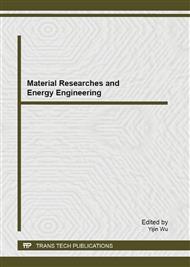[1]
Connolly P. Elastic impedance. The Leading Edge, 18(1999), pp.438-452.
Google Scholar
[2]
Gray F. D. Bridging the Gap: Using AVO to detect changes in fundamental elastic constants. Expanded Abstract of 69th SEG Mtg (1999), pp.852-855.
DOI: 10.1190/1.1821163
Google Scholar
[3]
Gray F. D., et al. The application of AVO and inversion to the estimation of rock properties. Expanded Abstracts of 70 th SEG Mtg(2000), pp.549-552.
DOI: 10.1190/1.1816120
Google Scholar
[4]
Sun P. Y. Advances in AVO techniques. Progress in Exploration Geophysics, 28(2005), pp.432-439.
Google Scholar
[5]
Eugene Lichman. Unified approach to gas and fluid detection on instantaneous seismic wavelets. SEG Technical Program Expanded Abstracts(2003), pp.1699-1702.
DOI: 10.1190/1.1817634
Google Scholar
[6]
Li L., Liu Sh. Y., Chen Zh. H., et al. Discussion of Absorption Attenuation Method. West-China Exploration Engineering, 22(2010), pp.143-145.
Google Scholar
[7]
Dong N., Yang L.Q. Application of absorption and attenuation based on wavelet transform for prediction of reservoir in tahe oilfield. Progress in Geophysics, 23(2008), pp.533-538.
Google Scholar
[8]
Bian Sh. T., Dong Y. L., Zheng J. M. Study on Application of Seismic Frequency Spectrum Attenuation to Detect Natural Gas. Oil Geophysical Prospecting, 42(2007), pp.296-301.
Google Scholar
[9]
Li ZH. CH., Wang Q. ZH. A review of research on mechanism of seismic attenuation and energy compensation. Progress in Geophysics. 22(2007), pp.1147-1152.
Google Scholar
[10]
Hudson J.A. Wave speeds and attenuation of elastic waves in material containing cracks, GeoPhys J.R. AstrSoe. (1981),pp.133-150.
DOI: 10.1111/j.1365-246x.1981.tb02662.x
Google Scholar
[11]
Hudson J.A. overall elastic properties of isotropic materials with arbitrary distribution of circular cracks,GeoPhys.J. Int. (1990),pp.465-469.
Google Scholar
[12]
S.E. Hough, J.M. Lees, and F. Monastero. Attenuation and Source Properties at the Coso Geothermal Area, California. Bulletin of the Seismological Society of America, 89(1999), pp.1606-1619.
DOI: 10.1785/bssa0890061606
Google Scholar
[13]
Rahul Dasgupta , Roger A. Clark, et al. Estimation of Q from surface seismic reflection data. Geophysics. 63(1995), pp.2120-2128.
DOI: 10.1190/1.1444505
Google Scholar
[14]
Zhang CH. J. and Tadeusz J. Ulrych et al. Estimation of quality factors from CMP records, Geophysics. 67: (1999), pp.1542-1547.
DOI: 10.1190/1.1512799
Google Scholar
[15]
Shi S. Q., Zhao Y. H. Research on gas-bearing prediction using AVO in sandstone reservoir with low-impedance, Sulige gas field[J]. Oil Geophysical Prospecting, 28(2003), pp.77-83.
Google Scholar


